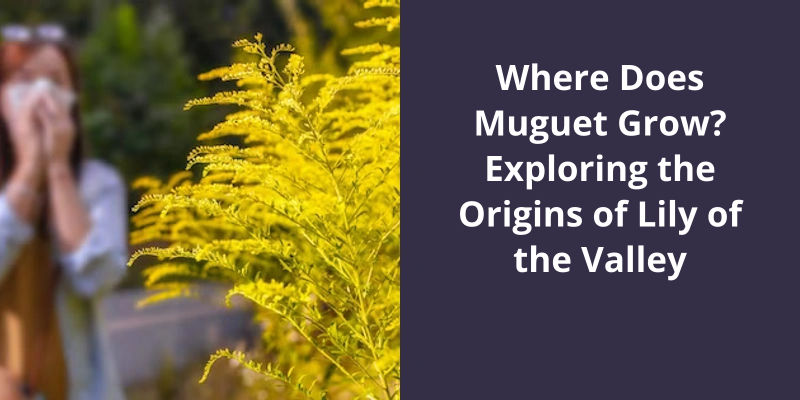Muguet, also commonly referred to as May bells, May lily, muguet, Mary's tears, and Our Lady's tears, is a highly scented flowering herbaceous perennial plant. This beautiful plant is known for it’s natural scent and is often used in perfumes and other fragrant products. Muguet normally grows in woodland and forested settings, making it a popular sight in natural settings. This plant is commonly found in cooler, temperate regions all around the world. This plant can be found in numerous locations all around the world, making it a truly global flower that continues to capture the imagination of many.

Is Muguet &Amp, Lily of the Valley the Same?
But is muguet the same as lily of the valley? Muguet is the French word for this sweet, delicate flower, which also goes by the botanical name Convallaria majalis.
The fragrance of muguet is unmistakable. It’s fresh, green, and floral, with a hint of sweetness that gives it a slightly powdery quality. It’s often used in perfumery to create light, feminine scents that are perfect for spring and summer. Muguet is also a popular note in home fragrances, particularly candles and diffusers.
In addition to it’s pleasant scent, muguet has a long history of symbolic meaning. In the language of flowers, muguet represents sweetness, purity, and the return of happiness. It’s often associated with May Day, a holiday that celebrates the arrival of spring. In France, it’s customary to give a sprig of muguet to loved ones on May 1st as a symbol of good luck.
Though muguet is primarily grown for it’s fragrance and ornamental value, it does have some medicinal properties. It’s leaves and flowers are rich in saponins, which are natural detergents that have been used for centuries to clean fabrics and skin. Muguet is also believed to have mild diuretic effects and may help to soothe inflammation. However, muguet should only be used under the guidance of a qualified healthcare provider.
Chemistry Behind the Fragrance of Muguet and It’s Use in Perfumery
- Muguet is a French word for lily-of-the-valley.
- The fragrance of muguet is due to the presence of several volatile organic compounds (VOCs).
- Important VOCs present in muguet include hydrocarbons, alcohols, and esters.
- Muguet fragrance is used in various perfumes and cosmetic products due to it’s pleasant and refreshing scent.
- Muguet fragrance is also used in air fresheners, candles, and other household products.
- The chemistry behind the fragrance of muguet is still not fully understood, and research is ongoing in this field.
- The study of fragrances and their chemical components is one of the major areas of research in the field of chemistry.
As the seasons change, so do the customs and traditions surrounding them. In France, one such tradition is the offering of muguet bouquets on May 1st. This gesture has a long history dating back to medieval times, but was officialized by King Charles IX in 156This sweet-smelling flower has come to symbolize the arrival of spring and has become an integral part of French culture. But why exactly do the French give muguet on May 1st? Let’s take a closer look.
Why Do the French Give Muguet on May 1st?
The tradition of giving muguet on May 1st has since evolved beyond just springtime celebrations. It’s now a symbol of luck and happiness, with many French people gifting small bunches of muguet to their loved ones and friends as a good luck charm. This is particularly true for students who offer muguet to their professors before an exam.
One of the reasons that muguet became associated with May 1st was due to it’s abundant growth during this time of year. The delicate white flowers bloomed in woodland clearings, and their sweet fragrance soon became synonymous with the freshness and vitality of springtime.
Muguet is also a symbol of solidarity and workers rights in France. May 1st, or Labor Day as it’s known in many countries, was established in France as a national holiday in 194It commemorates the struggles of the labor movement and the fight for workers rights. Many French people wear a sprig of muguet on their lapel on this day as a symbol of their support for the labor movement.
The significance of muguet extends beyond just cultural and historical contexts. In fact, the flowers are also believed to have healing properties. Muguet leaves and roots have been used in traditional medicine to treat a variety of ailments, such as stomach problems and headaches. The flowers are also said to have a calming effect on the mind and body, making them a popular ingredient in aromatherapy products.
It’s a beautiful and meaningful way to celebrate the joys of life, and a reminder of the power of tradition and community.
The History of May Day/Labor Day in France and Other Countries
May Day/Labor Day has a long history in France and other countries. It originated as a celebration of workers’ rights and has evolved over time to encompass various social and political causes. While it’s exact origins and traditions vary across different cultures, the holiday continues to be an important reminder of the ongoing struggle for fair labor practices and workers’ rights.
Conclusion
It’s distinguished by it’s highly scented flowers and is often found growing in woodland and forested areas. The plant's other whimsical names, such as Mary's tears and Our Lady's tears, further add to it’s enchanting mystique. If you happen upon a patch of muguet in your travels, take a moment to appreciate this delicate, yet hardy plant and it’s place in nature's grand design.





